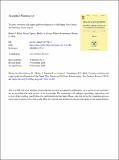Files in this item
Tectonic evolution and copper-gold metallogenesis of the Papua New Guinea and Solomon Islands region
Item metadata
| dc.contributor.author | Holm, Robert J. | |
| dc.contributor.author | Tapster, Simon | |
| dc.contributor.author | Jelsma, Hielke A. | |
| dc.contributor.author | Rosenbaum, Gideon | |
| dc.contributor.author | Mark, Darren F. | |
| dc.date.accessioned | 2019-11-10T00:37:55Z | |
| dc.date.available | 2019-11-10T00:37:55Z | |
| dc.date.issued | 2019-01 | |
| dc.identifier | 256566233 | |
| dc.identifier | 2fdb4715-e564-4d00-9258-279cd70e5a8b | |
| dc.identifier | 85056672086 | |
| dc.identifier | 000460710600014 | |
| dc.identifier.citation | Holm , R J , Tapster , S , Jelsma , H A , Rosenbaum , G & Mark , D F 2019 , ' Tectonic evolution and copper-gold metallogenesis of the Papua New Guinea and Solomon Islands region ' , Ore Geology Reviews , vol. 104 , pp. 208-226 . https://doi.org/10.1016/j.oregeorev.2018.11.007 | en |
| dc.identifier.issn | 0169-1368 | |
| dc.identifier.other | RIS: urn:579CCF4C55B6AC66B6BFDECDD8749469 | |
| dc.identifier.uri | https://hdl.handle.net/10023/18892 | |
| dc.description | S. Tapster acknowledges the funding from, and thanks the British Geological Survey University Funding Initiative PhD studentship (S176), NIGFSC (IP-1212-1110), and SEG Newmont Student Research grant (2274). This work could not have been possible without support provided by the Solomon Island Geological Survey and Ministry of Mines, Newmont Mining, SolGold (A.R.M) and the team of Allied Gold. | en |
| dc.description.abstract | Papua New Guinea and the Solomon Islands are in one of the most prospective regions for intrusion-related mineral deposits. However, because of the tectonic complexity of the region and the lack of comprehensive regional geological datasets, the link between mineralization and the regional-scale geodynamic framework has not been understood. Here we present a new model for the metallogenesis of the region based on a synthesis of recent studies on the petrogenesis of magmatic arcs and the history of subduction zones throughout the region, combined with the spatio-temporal distribution of intrusion-related mineral deposits, and six new deposit ages. Convergence at the Pacific-Australia plate boundary was accommodated, from at least 45 Ma, by subduction at the Melanesian trench, with related Melanesian arc magmatism. The arrival of the Ontong Java Plateau at the trench at ca. 26 Ma resulted in cessation of subduction, immediately followed by formation of Cu-Au porphyry-epithermal deposits (at 24-20 Ma) throughout the Melanesian arc. Late Oligocene to early Miocene tectonic reorganization led to initiation of subduction at the Pocklington trough, and onset of magmatism in the Maramuni arc. The arrival of the Australian continent at the Pocklington trough by 12 Ma resulted in continental collision and ore deposit formation (from 12 to 6 Ma). This is represented by Cu-Au porphyry deposits in the New Guinea Orogen, and epithermal Au systems in the Papuan Peninsula. From 6 Ma, crustal delamination in Papua New Guinea, related to the prior Pocklington trough subduction resulted in adiabatic mantle melting with emplacement of diverse Cu and Au porphyry and epithermal deposits within the Papuan Fold and Thrust Belt and Papuan Peninsula from 6 Ma to the present day. Subduction at the New Britain and San Cristobal trenches from ca. 10 Ma resulted in an escalation in tectonic complexity and the onset of microplate tectonics in eastern Papua New Guinea and the Solomon Islands. This is reflected in the formation of diverse and discrete geodynamic settings for mineralization within the recent to modern arc setting, primarily related to upper plate shortening and extension and the spatial relationship to structures within the subducting slab. | |
| dc.format.extent | 934692 | |
| dc.language.iso | eng | |
| dc.relation.ispartof | Ore Geology Reviews | en |
| dc.subject | Papua New Guinea | en |
| dc.subject | Solomon Islands | en |
| dc.subject | Copper | en |
| dc.subject | Gold | en |
| dc.subject | Metallogenesis | en |
| dc.subject | Tectonic reconstruction | en |
| dc.subject | GE Environmental Sciences | en |
| dc.subject | QE Geology | en |
| dc.subject | NDAS | en |
| dc.subject.lcc | GE | en |
| dc.subject.lcc | QE | en |
| dc.title | Tectonic evolution and copper-gold metallogenesis of the Papua New Guinea and Solomon Islands region | en |
| dc.type | Journal article | en |
| dc.contributor.institution | University of St Andrews. School of Earth & Environmental Sciences | en |
| dc.identifier.doi | https://doi.org/10.1016/j.oregeorev.2018.11.007 | |
| dc.description.status | Peer reviewed | en |
| dc.date.embargoedUntil | 2019-11-10 |
This item appears in the following Collection(s)
Items in the St Andrews Research Repository are protected by copyright, with all rights reserved, unless otherwise indicated.

